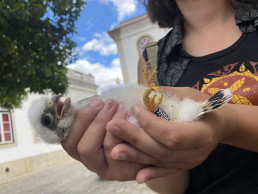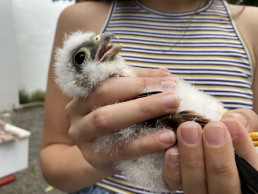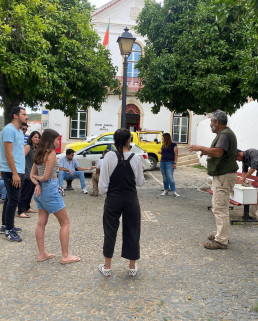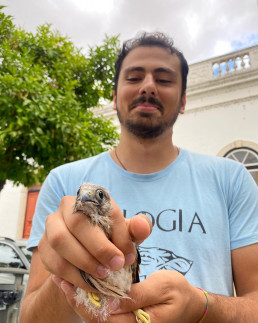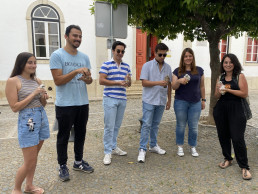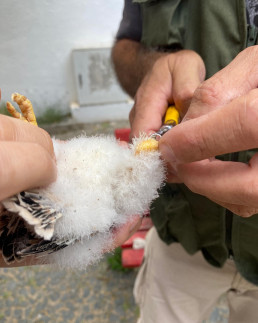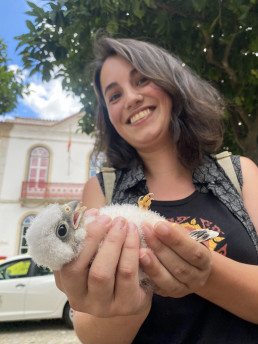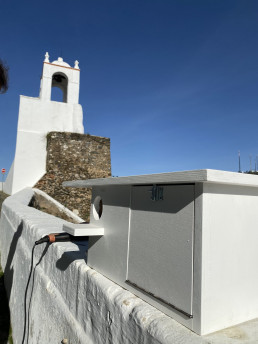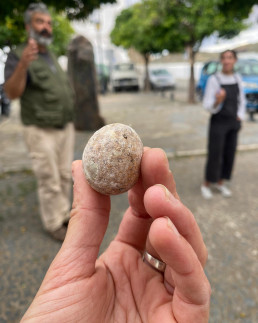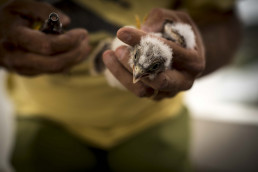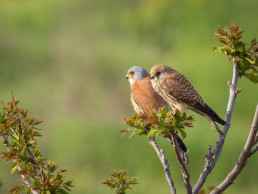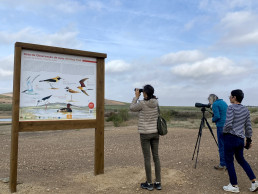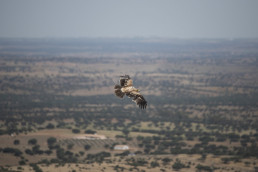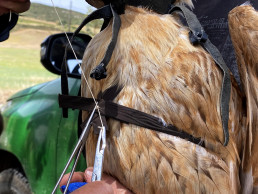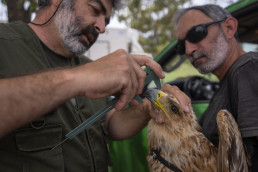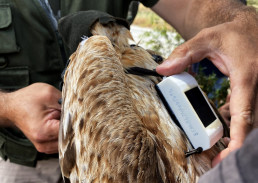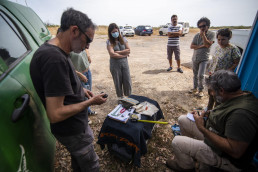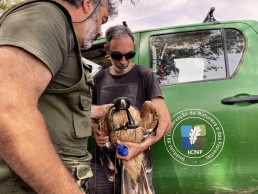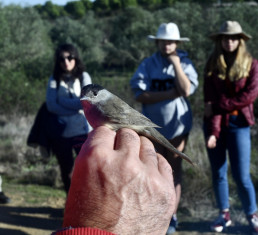Ringing the Lesser-Kestrel chicks
Today we ringed the Lesser-Kestrel chicks (Falco naumanni), born this year in the village of Mértola. Six chicks were ringed, and in one of the boxes we found an egg that did not hatch.
It is estimated that this year 13 to 15 pairs bred in Mértola, the last urban site in Portugal where the species still reproduces. In partnership with the Guadiana Valley Nature Park / ICNF and with the support of Mértola town council, we’re monitoring from close the reproductive success of the species and guaranteeing that they have a safe place to breed, year after year.
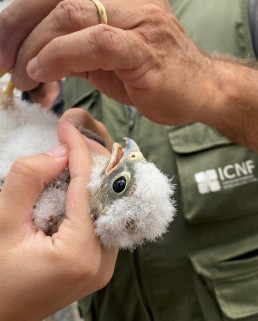

The public event began with a brief explanation of the ecology of the species. Carlos Carrapato, biologist in the Nature Park, explained the importance of the conservation measures implemented for this species.
Many participants had the opportunity to help ring one of the chicks, and learn in detail how to distinguish males and females. In one of the nest-boxes, the chicks were already displaying colourful plumage, revealing a more advanced stage, while the other three had less developed plumage.
In May, their mom showed us 3 incubating technics...

Find out about the conservation project to support the Lesser Kestrel colony in Mértola.
Ativities co-funded by Alentejo 2020 programme.
First Lesser-Kestrel chick born on Children's Day
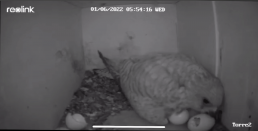
The first chicks of the Lesser Kestrel (Falco naumanni) of the breeding colony inside the village of Mértola, are now starting to come out of their shells. Thanks to the cameras that have been installed in nest boxes, we are following the breeding season of two families of the species. Mértola is the last urban place in Portugal where the species still breeds, with around 20 couples.
The cameras were installed by the Portugal Wildscapes Conservation Fund, in partnership with ICNF – the Guadiana Valley Natural Park, and Mértola municipality. Together, we are working to ensure long term continuity of the breeding colony, with the installation and maintenance of breeding boxes, installed for that purpose.
There are other small colonies in the Special Protection Area of Castro Verde and in the Guadiana Valley Nature Park, nesting in old ruins, cavities and, currently, also in nesting walls installed by LPN, as part of conservation projects for the species in Baixo Alentejo.

In the film recorded this morning, it is possible to observe a chick out of the egg, a semi-ecloded egg and also feeding moments, in which the mother offers small pieces of mouse to the chick, possibly brought by the male this morning.
This conservation measure allows us to better understand the feeding habits and the way they communicate, to study the behaviour of the species, and also to identify the right moment to ring the young before they leave the nest. A public ringing session will be held in June, on a date yet to be determined – as this will depend on the development of the chicks.
Learn more about the ongoing conservation programme for the Lesser-Kestrel
Take a look at our Birding Trail, to visit the right spots to watch them.
Birding Trail
Experience
The Birding Trail will guide you through ten very special spots between Mértola and Castro Verde. Covering distinct habitats, ranging from cereal steppes and steep river valleys to weirs and dams, there is an immense birdlife to discover throughout the different seasons.
The installation of the cameras is an initiative of Portugal Wildscapes, co-financed by Programa Operacional Regional do Alentejo – Alentejo 2020.
Iberian-Imperial-Eagle returned to nature after recovering from 14 shotgun pellets
This morning, Portugal Wildscapes accompanied the return to nature of an Iberian Imperial Eagle (Aquila adalberti), in Alcaria Ruiva, municipality of Mértola. Before being released, a GPS transmitter financed by the Portugal Wildscapes Conservation Fund was installed in his back.
This Iberian Imperial Eagle male was found in early March in Moura with 14 flares, in poor condition. During two and a half months it had an impressive recovery, thanks to the efforts of the LXCras team.
In a partnership with the National Institute for Nature Conservation and Forests – Guadiana Valley Nature Park, Portugal Wildscapes is contributing to the study of the species. A datalogger was installed on it, which transmits its geographical position in real time, allowing ICNF technicians to monitor its movements and thus analyse its dispersal habits.
This is an important conservation measure that allows us to deepen our knowledge of the species’ ecology and also to detect the death of individuals at an early stage (and thus be able to identify the cause and prevent further losses).
This is the second Iberian Imperial Eagle released with a gps transmitter funded by the Portugal Wildscapes Conservation Fund.
Soon we will give news about the location of the other released Iberian Imperial Eagle!
Find out more about the conservation project for Iberian Imperial eagle and other initiatives supported by Portugal Wildscapes.
Conservation
Experience
Alcaria: the Iberian-Imperial-Eagle that will tell us its location
The Iberian Imperial Eagle, which was later nicknamed Alcaria, was released in Alcaria Ruiva at the end of March.
It was rescued about 3 months ago and recovered at LXCras- Centre for the recovery of wild animals, a structure of the Lisbon City Hall.
A GPS transmitter was placed on the eagle’s back, financed by the Portugal Wildscapes Conservation Fund, in the scope of our partnership with the Parque Natural do Vale do Guadiana – ICNF.
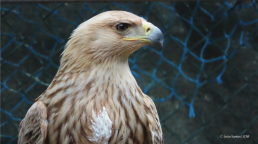
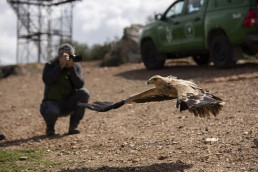
Photos by João Santos – ICNF
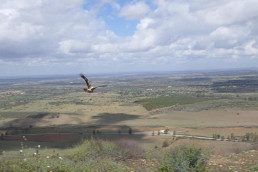
This conservation action will allow us to follow the eagle’s movements and learn about its ecological and dispersal habits. In the future, when it reaches sexual maturity, it will allow us to understand which territories it will choose to nest in.
